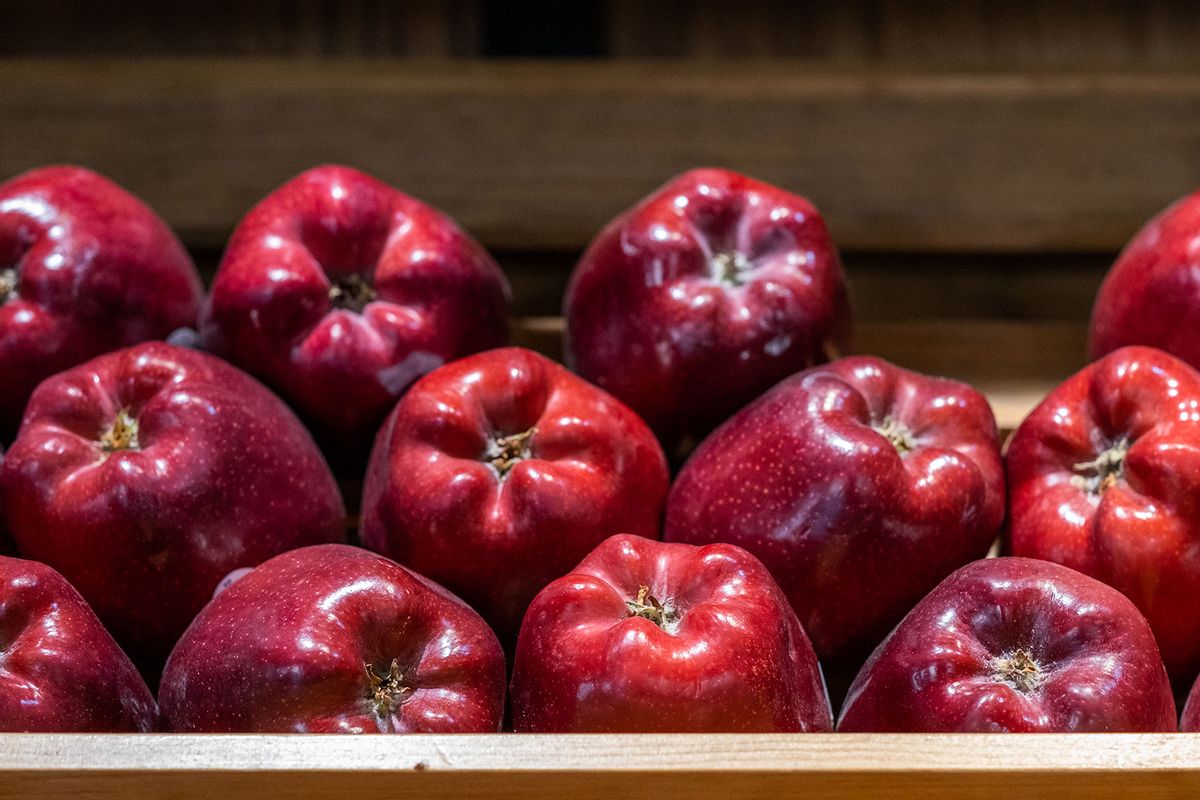When it comes to ranking apples, some may pledge allegiance to the crisp and crunchy Pink Ladies, while others may hail the tart Granny Smiths as the superior variety. But almost everyone can agree that the worst (we're talking bottom of the bottom-est tier here) kind of apple to ever exist is most definitely the Red Delicious.
It's truly such a shame, considering that the word "delicious" is literally in the apple's name. But nothing about it even screams delicious, appetizing or tasty. Biting into a Red Delicious is always a major gamble because oftentimes, you'll be anticipating a nice juicy chomp, only to fill your mouth with mushy, brown-hued bits of fruit. So is the apple's skin, which could be incredibly shiny on one side and all soft and splotchy on the other. And don't even get us started on chewing a Red Delicious. Not only is it painful to do so, but it also takes forever to soften the apple before it can be properly swallowed.
On top of that, Red Delicious is an absolute pain to cook with. Forget about including them in pies, crisps or crumbles, you can't even add the dang apple into salads because they are both an aesthetic and gustatory nightmare.
The Red Delicious isn't actually delicious anymore. And yet, the apples are a common sight across grocery stores, local markets and school cafeterias. Why is this?
Red Delicious enjoyed its prime time in the 1980s and unfortunately, the apple's rapid popularity led to its subsequent downfall.
During its heyday, the Red Delicious was indeed delicious, but it was still regarded as simple — the apple's taste was good and its exterior wasn't anything remarkable. As noted by Rowan Jacobsen in his book "Apples of Uncommon Character," the fruit itself "kept well and had an inoffensive, pleasantly aromatic taste."
"Most of all, it was very sweet. What it wasn't was solid red; instead, it had a light pink blush, reddish stripes, and a less pronounced strawberry shape, making it a pretty generic apple."
Of course, with popularity also came mass production. And with mass production also came newfound competition amongst farmers to see who could bear the most beautiful — in this case, the reddest — apples possible. The Red Delicious was first discovered by a farmer named Jesse Hiatt, who stumbled upon a unique looking apple tree growing in his Peru, Iowa, orchard. That tree produced a "delicious, crisp, red-and gold-streaked fruit," as described by The Counter's Tove Danovich. And that fruit ultimately wowed a man named C.M. Stark, whose company Stark Brothers Nurseries and Orchards hosted an apple contest in 1894.
We need your help to stay independent
Stark immediately secured the rights to the Red Delicious and heavily marketed both the apple and its tree to curious customers. The apple was also incredibly enticing to countless farmers, who reached out to Stark in hopes of securing the tree so they could plant it on their own. After one grower noticed that a mutated branch on his Red Delicious tree bore deep crimson red fruits, other Delicious growers raced to spot similar mutations that would produce vibrant, striking red apples.
"As the Red Delicious continued to evolve, subsequent breeding privileged physical appearance and durability over taste," Danovich wrote. In other words, apple growers and supermarkets began selling redder apples to convince consumers that redder meant riper and also, better.
Danovich continued, "The famous dimpled, coke-bottle bottom made the apple easy to stack and transport, while the tough skin reduced bruising and helped improve shelf life." By the 1980s, the Red Delicious made up 75 percent of the entire apple crop grown in Washington.
But its taste wasn't the same as before. The Red Delicious was now less delicious and more . . . gross.
Want more great food writing and recipes? Subscribe to Salon Food's newsletter, The Bite.
On top of that, the apples were overshadowed by newer, tastier varieties like the Honeycrisp and Gala. People craved crispier, juicier, sweeter and tarter apples — qualities the Red Delicious failed (and continues to fail) to deliver.
Today, the apples are still grown in large amounts mainly because it's difficult and incredibly costly for Red Delicious farmers to switch over to a different variety. The apples have also become a major export fruit, thanks to their thick skin, low cost and red exterior. As of 2018, over half of the U.S.'s Red Delicious crop is exported. But still, approximately 580 million pounds of the apples are left behind to be consumed nationwide.
Grocery stores and other major food businesses are still buying Red Delicious en masse, even though they are aware that the variety has declined in popularity in recent years. That being said, consumers are pretty cognizant of the fact that Red Delicious are pretty abysmal. Just take it from the folks over at Reddit, who never refrain from bashing the apples.
"Change the name to 'red long lasting,'" wrote one user, while another said, "Yep. They're not delicious anymore." A few haters even came up with a few alternative names for the apples:
"Red Okay-ish."
"Red durable."
And finally, "Red shelf stable."

Shares